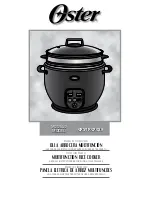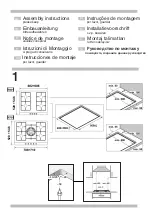
7
• The A-weighted emission sound pressure level does not exceed 70 dB(A).
• Turn the appliance off in case of fault or poor operation.
• Do not use products (even if diluted) containing chlorine (sodium hypochlorite,
hydrochloric or muriatic acid, etc.) to clean the appliance or the floor under it.
• Do not use metal tools to clean steel parts (wire brushes or Scotch Brite type scouring
pads).
• Do not allow oil or grease to come into contact with plastic parts. Do not allow dirt, fat,
food or other residuals to form deposits on the appliance.
• Do not spray water or use water jets or steam cleaner.
• Do not store or use gasoline or other flammable vapours, liquids or items in the vicinity of
this or any other appliance.
• Do not spray aerosols in the vicinity of this appliance while it is in operation.
A.4
Induction general safety
• The hotplate cannot be cooled with direct jets of water, intentional or accidental (e. g.
when filling pots with water from a side pourer or spill onto the hot-plate).
• The glass-ceramic top (6mm thickness) could be damaged due to punctiform impacts (e.
g. falling of metal object on the surface) or hard handling of the pots.
• If the surface is damaged or cracked, immediately disconnect the appliance or
appropriate part of the appliance from the supply.
• During every normal cooking process the glass-ceramic top is very hot and therefore
must not be touched (burns danger).
• During every normal cooking process must not be left empty pans onto the glass-
ceramic top (overheating danger).
• During every normal cooking process do not place paper, cardboard, cloths, etc.,
between the pot and the glass-ceramic top (risk of fire).
• During every normal cooking process no other object (e.g. plastic vessels, closed tinned
foods, aluminium foil, cutlery or other metal objects) except pots, must be placed on the
hotplate (burns danger). The hotplate must not be used as a rest surface.
• If a splashguard device is used for cooking, it must not have a metal surface.
• During every normal cooking process, objects such as rings, watches, etc., worn by the
user can become very hot if brought near the surface of the appliance (burns danger).
•
Anyone fitted with a pacemaker or other metal implants can suffer life-threatening
injuries when using induction appliances
. Ask the manufacturer of your implant or
consult your doctor about possible risks before using the cooker.
• Every kind of objects that react to magnetisation (e. g. credit cards, telephone cards,
etc.) must not be placed near or above the glass-ceramic top.
• The induction appliance has internal air cooling. The air intake and outlet openings
located under the appliance must not be blocked with objects or cloths (overheating
danger).
• At the end of cooking always switch off the cooking zones by positioning the relatives
control knobs in the off position.
• It is advisable to use pots specially designed for this induction appliance (refer to G.1.1
), otherwise the appliance may malfunction or become damaged.
A.5
General safety rules
Protection devices installed on the machine
• The guards on the machine are:
fixed guards (e.g. casings, covers, side panels, etc.), fixed to the machine and/or frame
with screws or quick-release connectors that can only be removed or opened with tools.








































